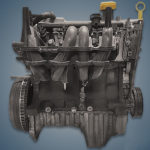The Renault D4Ft 1.2-liter turbo engine or 1.2 TCe 100 was produced from 2007 to 2013 and was installed in the company’s compact models such as Twingo, Clio, Modus and Wind. This power unit is essentially a turbocharged modification of the popular D4F engine.
The TCe line includes engines: H4Bt, H4Dt, H5Dt, D4Ft, H5Ft, H5Ht, H4Jt, M5Mt, M5Pt, F4Rt.
In 2007, a new turbo engine based on the well-known D4F unit debuted on the Clio 3 model. The engineers did not just add a turbine with an intercooler to a conventional engine, there is another cylinder head, a seriously reinforced connecting rod and piston group and oil nozzles for cooling the pistons. An in-line cast-iron block for 4 cylinders, a single camshaft controlling 16 valves, a timing belt drive, and a distributed fuel injection system remained from the old engine.
The most widespread are four modifications of these power units:
- 780 for 74 kW or 101 hp, 145 Nm were installed on Twingo (2007 – 2011), Wind (2010 – 2011);
- 782 for 75 kW or 102 hp, 155 Nm were installed on Twingo (2011 – 2013), Wind (2011 – 2013);
- 784 for 74 kW or 101 hp, 145 Nm was installed on Clio (2007 – 2011), Modus (2007 – 2011);
- 786 for 76 kW or 103 hp, 155 Nm was installed on Clio (2011 – 2012), Modus (2011 – 2012).
Specifications
| Production years | 2007-2013 |
| Displacement, cc | 1149 |
| Fuel system | injector |
| Power output, hp | 100 – 103 |
| Torque output, Nm | 145 – 155 |
| Cylinder block | cast iron R4 |
| Block head | aluminum 16v |
| Cylinder bore, mm | 69 |
| Piston stroke, mm | 76.8 |
| Compression ratio | 9.5 |
| Hydraulic lifters | no |
| Timing drive | belt |
| Turbocharging | yes |
| Recommended engine oil | 5W-30, 5W-40 |
| Engine oil capacity, liter | 4.8 |
| Fuel type | petrol |
| Euro standards | EURO 4/5 |
| Fuel consumption, L/100 km (for Renault Clio 2010) — city — highway — combined |
7.9 5.2 6.3 |
| Engine lifespan, km | ~300 000 |
| Weight, kg | 91 |
The engine was installed on:
- Renault Clio 3 (X85) in 2007 – 2012;
- Renault Modus 1 (J77) in 2007 – 2012;
- Renault Twingo 2 (C44) in 2007 – 2013;
- Renault Wind 1 (E33) in 2010 – 2013.
Disadvantages of the Renault D4Ft engine
- This motor is quite reliable and most of its problems are due to the vagaries of electricians. Most often, sensors fail here, and an expensive ignition coil also fails.
- According to the manual, the timing belt changes every 120,000 km, but it can break even earlier. So keep an eye on its condition, because when it breaks in this motor, the valves always bend.
- The main culprit for loud noises under the hood are unadjusted valves. To adjust them, you need to remove not only the valve cover, but also the intake manifold.
- Even in this unit, lubricant and coolant leaks are quite common, attachments often fail, and the fuel pump is not very reliable.






